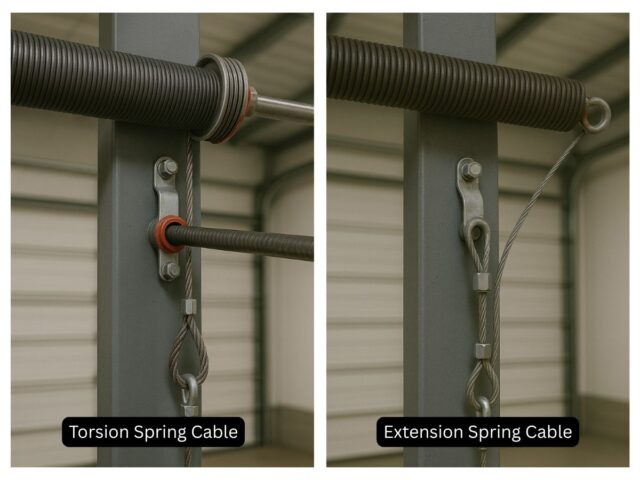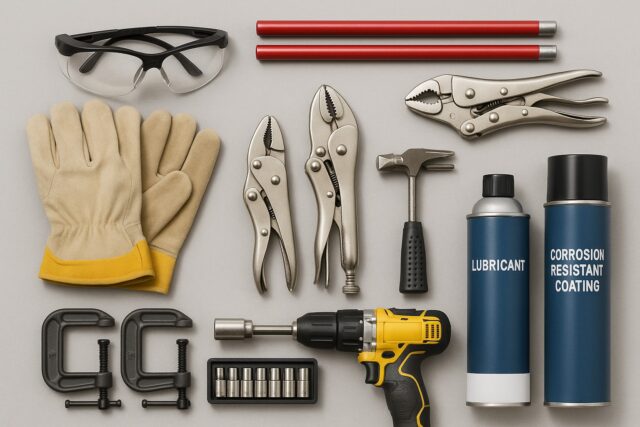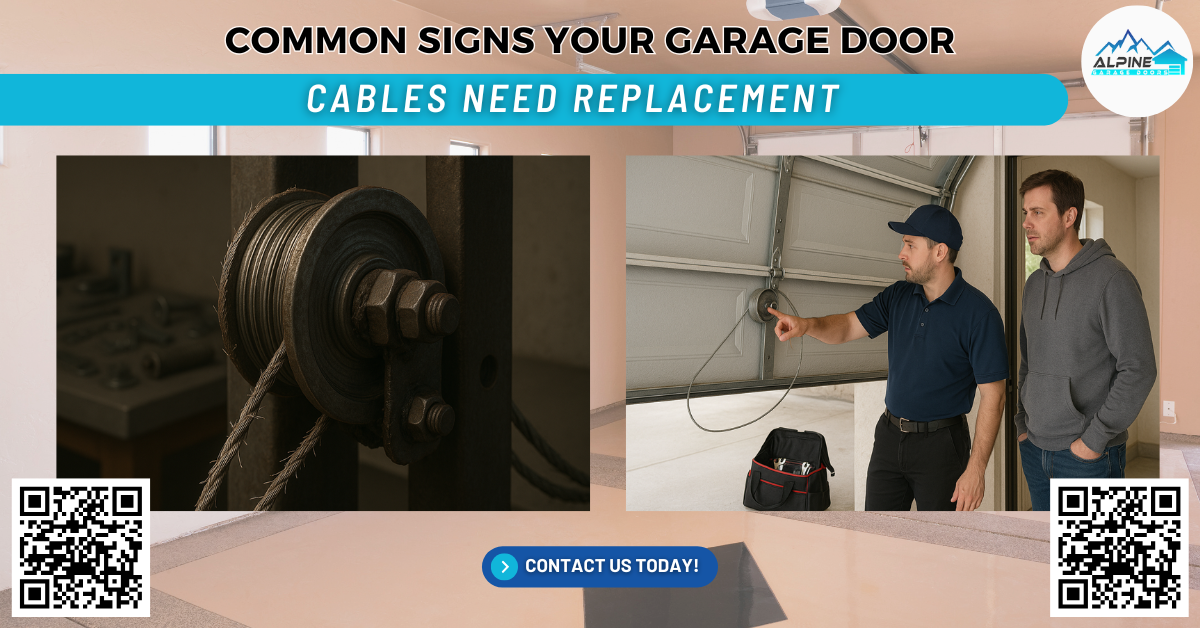When your garage door stops working, it can disrupt your entire day. One of our recent customers in Atascocita learned this the hard way. Her garage door jammed halfway, creating a dangerous and inconvenient situation. When our professional garage door technicians arrived, we discovered the culprit: a frayed and slack cable that had slipped off the drum and compromised the entire system. We performed a garage door cable replacement, restoring smooth operation within the hour. This kind of problem is more common than many homeowners realize and highlights the importance of knowing the signs of failing cables.
According to the U.S. Consumer Product Safety Commission, thousands of injuries occur each year due to faulty garage door systems. Garage doors are not only heavy but are also under extreme tension. Springs and cables work together to safely raise and lower the door. When a cable breaks or begins to wear out, it can affect the entire garage door system, including the opener, pulley system, and even the torsion tube. Replacing worn or broken garage door cables is a critical step in maintaining your door’s safety and reliability.
If you’re a homeowner in Atascocita, Houston, or the surrounding areas, understanding the warning signs of worn garage door cables can save your family time, money, and keep your garage door working safely. In this comprehensive guide, Alpine Garage Doors Texas walks you through everything you need to know about garage door cable replacement, including the parts involved, the repair process, and why regular maintenance is essential for your home.
What Are Garage Door Cables and Why Are They Important?
Garage door cables are essential components that work in conjunction with springs to ensure the safe and balanced operation of garage doors. These cables, typically made of strong steel wire, are designed to withstand the high tension necessary to lift and lower heavy doors. They attach to the bottom brackets on the garage door and wind around cable drums mounted on either side of the torsion tube.
There are two main types of garage door cables:
- Torsion Spring Cables: Used with torsion spring systems, these cables are wound tightly around drums when the door is closed and unwind as the door opens.
- Extension Spring Cables: These are used in systems with extension springs and typically run through pulleys before attaching to the bottom bracket of the door.

Garage door cables play a vital role in counterbalancing the weight of the door, working hand-in-hand with torsion springs or extension springs. Without them, the springs would not be able to perform their function, and the door would not open or close properly. More importantly, garage door cables provide an essential safety measure. If a spring fails, the cables help prevent the door from crashing down, avoiding serious injury or damage.
Why Garage Door Cable Replacement Is Crucial
Garage door cable replacement is not just a repair task; it’s a safety measure. Garage doors are one of the heaviest moving parts in your home. When the cables become worn, frayed, or snap, the door can become misaligned, unstable, or completely inoperable. In some cases, the door may fall abruptly, damaging vehicles or causing injury to people or pets.
Garage door cables are constantly under high tension, which means they can wear out faster than you might expect. Environmental factors like moisture, rust, and dust can accelerate wear and corrosion. Without regular maintenance, even the most durable cables can become brittle or frayed. Damaged cables affect other parts too, including the drum, pulleys, garage door springs, and the garage door opener, potentially leading to further damage.
Replacing damaged or old cables is an essential part of garage door maintenance. It’s important to treat garage door cable replacement as a part of routine preventive maintenance rather than waiting for a complete failure.
Common Signs Your Garage Door Cables Need Replacement
Recognizing the signs of failing garage door cables early can help you avoid more serious repairs or dangerous situations. Here are the most common signs:
1. Visible Fraying or Corrosion
Fraying cables will have strands of metal sticking out or visibly split wires. Rust on cables is another red flag. Corroded cables are weakened and can snap unexpectedly.
2. Slack or Loose Cables
Garage door cables should be taut. If you notice sagging or slack cables near the bottom brackets or cable drums, they may have slipped out of place or stretched beyond their useful length.
3. Uneven or Crooked Door
If one side of the garage door seems higher than the other or doesn’t close evenly, a cable may be stretched or broken. This unbalanced operation can cause strain on other parts, including torsion springs and garage door openers.
4. Strange Noises
Grinding, squeaking, or banging sounds during operation often indicate cable or pulley system issues. This can also signal problems with the torsion tube, spring tension, or cable drums.
5. Sudden Door Drops
A working cable helps ensure smooth and controlled door motion. If your door suddenly drops or slams shut, it could be due to a broken cable or spring.
6. The Door Doesn’t Open at All
When cables are completely broken, the opener may struggle or fail to lift the door, even though it’s running. This can damage the opener and stress the entire garage door system.
7. Cable Off the Drum
If the cable slips off the drum, it will no longer guide the door properly. This usually results in a crooked or jammed garage door and requires immediate repair.
Causes of Garage Door Cable Damage
Garage door cable damage can occur due to a variety of reasons. Understanding these causes can help you prevent premature failure and take action when needed:
- Normal Wear and Tear: Repeated opening and closing naturally cause friction on the cables, leading to gradual wear.
- Lack of Maintenance: Without regular inspections, minor fraying or slack cables can go unnoticed until they break.
- Moisture and Rust: Exposure to humidity or water causes cables to corrode, weakening the metal over time.
- Misaligned Drums or Pulleys: If the drums or pulleys are not aligned properly, it puts uneven tension on the cables.
- Improper Installation: Incorrect installation of the garage door system can lead to uneven load distribution and early failure of cables.
- Damaged Springs: When garage door springs fail or lose tension, the cables compensate by taking on more of the load than designed.
DIY Cable Replacement vs. Professional Help
While it may be tempting to try a DIY garage door repair, garage door cable replacement is not recommended for amateurs.
Why DIY Can Be Dangerous
Garage doors operate under extreme tension. The springs and cables work as a system, and mishandling either component can result in serious injury. Using incorrect tools, failing to relieve spring tension properly, or installing the wrong cable can lead to further damage and safety hazards.
The Advantages of Professional Garage Door Services
- Proper Safety Precautions: Trained technicians use personal protective equipment (PPE) like gloves, safety glasses, and secure ladders to safely complete the task.
- Right Tools and Parts: Professionals bring the right tools and correct cable sizes for your garage door model.
- Inspection of Entire System: A professional technician will check springs, rollers, drums, and the garage door opener during the service call.
- Efficient and Guaranteed Work: Services often include warranties and ensure that the job is done right the first time.

If you value safety, reliability, and proper functioning of your garage door, it’s best to leave cable replacement to the professionals.
Preventive Maintenance Tips
Taking simple steps to care for your garage door cables and other parts can extend their lifespan and keep your garage door system working reliably. Here are some easy steps you can follow:
- Inspect Cables Monthly: Look for signs of fraying, rust, or slack cables. Check the drum and bottom brackets for wear.
- Lubricate Moving Parts: Use garage door lubricant on the springs, pulleys, and cables every few months. Avoid household lubricants like WD-40.
- Listen for Noises: Grinding or squealing noises often signal a problem with the tension, pulley system, or worn parts.
- Schedule Annual Tune-Ups: Have a professional inspect your system annually to catch issues before they become costly repairs.
- Clean Tracks and Components: Keep dirt and debris away from the drum, pulley, and cable systems.
By following these maintenance steps, you can prevent cable wear and avoid unexpected garage door repairs.
Step-by-Step Guide to What Happens During Cable Replacement
If you’re scheduling a garage door cable replacement, here’s a general overview of what professional technicians do during the process:
- Inspection and Diagnosis: The technician inspects the garage door, cables, springs, drums, and opener system.
- Safety Setup: They use PPE and secure the door to prevent accidental movement. They will also disconnect the garage door opener.
- Release Spring Tension: Carefully releasing the spring tension is a critical safety step.
- Remove the Damaged Cable: The technician loosens setscrews, removes the old cable from the bottom bracket and drum.
- Install New Cable: The new cable is carefully threaded and wrapped around the drum in alignment with the torsion tube.
- Re-tension the Springs: After installing the cable, the technician adjusts spring tension to ensure balanced door movement.
- Test the Door Operation: They test the door multiple times to ensure smooth and safe operation.
- Final Safety Check: A final inspection confirms that all parts are secure and working properly.
This step-by-step process ensures that your garage door is restored to proper working condition, providing safety and reliability for your home.
How Can Alpine Garage Doors Texas Help You?
At Alpine Garage Doors Texas, we specialize in comprehensive garage door services, including garage door cable replacement. Serving families and businesses in Atascocita, Houston, and surrounding communities, we provide reliable solutions for broken cables, garage door spring issues, opener problems, and complete garage door system maintenance.
Our trained technicians use the right tools and follow a proven step-by-step process to ensure safe operation and long-term durability. Whether your garage door cable is frayed, off the drum, or completely snapped, we can help. We also offer emergency repair services, routine maintenance, and new garage door installation.
- Location: 638 Saddle Rock Dr, Houston, TX 77037
- Phone: 346-438-1138
Call us today to schedule a free inspection or learn more about how we can help protect your home with reliable garage door repair and maintenance services.
Final Thoughts
Garage door cable issues can be dangerous, disruptive, and expensive if left unattended. By learning the common signs of damage and understanding the importance of cable replacement, homeowners can take proactive steps to keep their garage doors in top condition. Routine inspections, preventive maintenance, and knowing when to call a professional can make all the difference.
At Alpine Garage Doors Texas, your safety and peace of mind are our top priorities. Don’t wait for a broken cable to become a serious problem. Whether you need a repair, new cables, or full garage door replacement, we’re here to help. Contact us today for expert service you can trust.
Frequently Asked Questions (FAQs)
1. Can garage door cables be repaired, or do they always need to be replaced?
Garage door cables cannot be safely repaired; if they are frayed, stretched, or broken, full replacement is the only safe and effective solution.
2. How do I know what type of cable my garage door uses?
The type depends on your spring system, torsion spring systems use torsion cables, while extension spring systems use extension cables. A technician can confirm the correct type for your door.
3. Is it normal for garage door cables to stretch over time?
Yes, cables can stretch slightly with use, but significant slack or uneven movement usually indicates it’s time for replacement.
4. How long does a professional cable replacement service take?
Most garage door cable replacements by a professional technician can be completed in about 1 to 2 hours, depending on the system’s condition.

